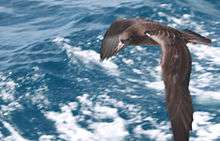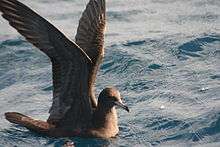Flesh-footed shearwater
| Flesh-footed shearwater | |
|---|---|
 | |
| Scientific classification | |
| Kingdom: | Animalia |
| Phylum: | Chordata |
| Class: | Aves |
| Order: | Procellariiformes |
| Family: | Procellariidae |
| Genus: | Ardenna |
| Species: | A. carneipes |
| Binomial name | |
| Ardenna carneipes (Gould, 1844) | |

The flesh-footed shearwater (Ardenna carneipes; formerly Puffinus carneipes) is a medium-sized shearwater. Its plumage is black. It has pale pinkish feet, and a pale bill with a distinct black tip. Together with the equally light-billed pink-footed shearwater, it forms the Hemipuffinus group, a superspecies which may or may not have an Atlantic relative in the great shearwater.[2][3] These are large shearwaters which are among those that have been separated in the genus Ardenna.[4]
It breeds in colonies, and has two main breeding areas: one in the southwest Pacific Ocean includes Lord Howe Island (16,900 pairs [5]), South Australia (~1,800 pairs breeding on two islands [6]), and northern New Zealand (13,000 pairs [7]); the other population comprises no more than 36,000 pairs breeding on 42 islands along the coast of Western Australia from Cape Leeuwin to the Recherche Archipelago.[8] Another 500 pairs breed on St Paul Island in the Indian Ocean. There is an unconfirmed record of birds on Astola Island of Pakistan in the Arabian Sea. There is recent evidence to suggest populations are declining across much of the species range.[9][10][11][12][13] The species was recently listed as 'Near Threatened' in Australia [14] and 'Nationally Vulnerable' in New Zealand [15] and has been recommended for listing under the Agreement on the Conservation of Albatrosses and Petrels.[16] At the state level, the species is listed as Vulnerable in WA [17] and NSW and Rare in SA.
The species occurs as a (Boreal) summer visitor in the North Pacific Ocean [18] where potentially large numbers are taken as bycatch in fisheries.[19][20] The species also suffers from climate related impacts [21] and significant heavy metal contamination, the cause of which is not fully understood but is likely due to the ingestion of significant quantities of plastic which the birds mistake for food floating on the ocean surface.[22][23][24]
References
- ↑ BirdLife International (2012). "Ardenna carneipes". IUCN Red List of Threatened Species. Version 2013.2. International Union for Conservation of Nature. Retrieved 26 November 2013.
- ↑ Austin, J.J. (1996) Molecular phylogenetics of Puffinus shearwaters: preliminary evidence from mitochondrial cytochrome b gene sequences. Molecular Phylogenetics and Evolution 6, 77-88
- ↑ Austin, J.J., Bretagnolle, V., Pasquet, E., 2004. A global molecular phylogeny of the small Puffinus shearwaters and implications for systematics of the Little–Audubon's Shearwater complex. Auk 121: 847–864
- ↑ Penhallurick, J., and Wink, M. (2004) Analysis of the taxonomy and nomenclature of the Procellariiformes based on complete nucleotide sequences of the mitochondrial cytochrome b gene. Emu 104: 125-147
- ↑ Reid T, Hindell M, Lavers JL, Wilcox C (2013) Re-examining mortality sources and population trends in a declining seabird: using Bayesian methods to incorporate existing information and new data. PLoS One 8:e58230
- ↑ Lavers J. 2014. Population status and threats to Flesh-footed Shearwaters (Puffinus carneipes) in South and Western Australia. ICES Journal of Marine Science. doi:10.1093/icesjms/fsu164
- ↑ Waugh, S. M., Tennyson, A., Taylor, G., and Wilson, K.-J. 2013. Population sizes of shearwaters (Puffinus spp.) breeding in New Zealand, with recommendations for monitoring. Tuhinga, 24: 159–204.
- ↑ Lavers J. 2014. Population status and threats to Flesh-footed Shearwaters (Puffinus carneipes) in South and Western Australia. ICES Journal of Marine Science. doi:10.1093/icesjms/fsu164
- ↑ Reid T, Hindell M, Lavers JL, Wilcox C (2013) Re-examining mortality sources and population trends in a declining seabird: using Bayesian methods to incorporate existing information and new data. PLoS One 8:e58230
- ↑ Waugh SM, Tennyson A, Taylor G, Wilson K-J (2013) Population sizes of shearwaters (Puffinus spp.) breeding in New Zealand, with recommendations for monitoring. Tuhinga 24:159-204
- ↑ Priddel D, Carlile N, Fullagar P, Hutton I, O'Neill L (2006) Decline in the distribution and abundance of Flesh-footed Shearwaters (Puffinus carneipes) on Lord Howe Island, Australia. Biological Conservation 128:412-424
- ↑ Waugh, S.M., Tennyson, A., Taylor, G., and Wilson, K.-J. (2013) Population sizes of shearwaters (Puffinus spp.) breeding in New Zealand, with recommendations for monitoring. Tuhinga 24: 159-204
- ↑ Lavers J. 2014. Population status and threats to Flesh-footed Shearwaters (Puffinus carneipes) in South and Western Australia. ICES Journal of Marine Science. doi:10.1093/icesjms/fsu164
- ↑ Garnett S, Szabo J, Dutson G (2011) The Action Plan for Australian Birds 2010.
- ↑ Robertson HA, Dowding JE, Elliott GP, Hitchmough RA, Miskelly CM, O’Donnell CFJ, Powlesland RG, Sagar PM, Scofield RP, Taylor GA. 2013. Conservation status of New Zealand birds 2012. New Zealand Threat Classification Series 4. Department of Conservation, Wellington
- ↑ Cooper J, Baker GB, 2008. Identifying candidate species for inclusion within the Agreement on the Conservation of Albatrosses and Petrels. Marine Ornithology 36: 1-8.
- ↑ DPaW, 2015. Wildlife conservation (specially protected fauna) notice 2015, Government gazette of Western Australia. Department of Parks and Wildlife, Perth
- ↑ Bond AL and Lavers JL. 2015. Flesh-footed Shearwaters (Puffinus carneipes) in the north-eastern Pacific Ocean: a summary and synthesis of records from Canada and Alaska. Canadian Field-Naturalist 129: 263-267
- ↑ Reid T, Tuck GN, Hindell MA, Thalmann S, Phillips RA, Wilcox C (2013) Nonbreeding distribution of Flesh-footed Shearwaters and the potential for overlap with north Pacific fisheries. Biological Conservation 166:3-10
- ↑ Lavers JL, Bond AL, Van Wilgenburg SL, and Hobson KA. 2013. Linking at-sea mortality of a pelagic shearwater to breeding colonies of origin using biogeochemical markers. Marine Ecology Progress Series 491:265-275
- ↑ Bond AL, Lavers JL (2014) Climate change alters the trophic niche of a declining apex marine predator. Global Change Biology 20: 2100-2107
- ↑ Bond AL, Lavers JL (2011) Trace element concentrations in feathers of Flesh-footed Shearwaters (Puffinus carneipes) from across their breeding range. Archives of Environmental Contamination and Toxicology 61:318-326
- ↑ Lavers JL, Bond AL, Hutton I (2014) Plastic ingestion by Flesh-footed Shearwaters (Puffinus carneipes): implications for fledgling body condition and the accumulation of plastic-derived chemicals. Environmental Pollution 187: 124-129
- ↑ Hutton I, Carlile N, Priddel D, 2008. Plastic ingestion by Flesh-footed Shearwaters, Puffinus carneipes, and Wedge-tailed Shearwaters, Puffinus pacificus. Papers and Proceedings of the Royal Society of Tasmania 142: 67-72
